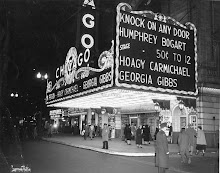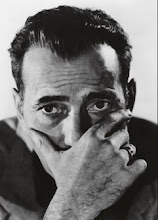THIS IS IT is the show we never got to see. Culled from more than a hundred hours of video footage of the Los Angeles rehearsals earlier this year for his planned farewell show in London, it portrays Jackson as an entertainer still at the top of game despite having turning fifty and endured years of ridicule for his off-stage behaviour. Rightly or wrongly those lurid stories of his private life suddenly seem small and irrelevant when watching him on stage breathing new life into classics like "Billie Jean", "I Just Can't Stop Loving You", "The Way You Make Me Feel", "Black or White", "Beat It" and, of course, "Thriller." It's impossible to top the John Landis directed 1983 video for the latter and wisely Jackson and show director Kenny Ortega don't try, opting instead for a reimagining which combines 3D video with live action.
Lavish though the new "Thriller" routine is, for me the highlight of THIS IS IT is "Smooth Criminal" which blends a film noir mini-movie starring Jackson alongside Rita Hayworth, Humphrey Bogart and Edward G Robinson with punchy on-stage choreography.
Cut through all of the speculation about Jackson's motivations for his comeback and whether he was fit enough to handle the demands of a 50 show run and one thing is very clear; "This Is It" (the show) certainly wouldn't have been a cynical minimum effort maximum profit stroll through Jackson's greatest hits. THIS IS IT (the film) proves that Jackson intended it to be bigger and more spectacular than anything he'd done before and that he was completely involved in aspect of the production, and the music in particular. He's polite but demanding with the musicians as he directs them to create exactly the same sounds that he's imagining.
 Much has been written since Jackson's death about the state of his health during these rehearsals with some claiming he was obviously unwell and others countering that he was in excellent health. From the evidence presented in THIS IS IT he looks thin, particularly when compared with the lithe and muscular dancers surrounding him, most of whom are 25 - 30 years younger, but he doesn't display any problems in matching them move for move. Admittedly he doesn't participate in their pirouettes and backflips but that's not his job. He sings and dances his way through numerous routines without appearing out of breath which is considerably more than most 50 year old men can manage.
Much has been written since Jackson's death about the state of his health during these rehearsals with some claiming he was obviously unwell and others countering that he was in excellent health. From the evidence presented in THIS IS IT he looks thin, particularly when compared with the lithe and muscular dancers surrounding him, most of whom are 25 - 30 years younger, but he doesn't display any problems in matching them move for move. Admittedly he doesn't participate in their pirouettes and backflips but that's not his job. He sings and dances his way through numerous routines without appearing out of breath which is considerably more than most 50 year old men can manage.It would be wrong to suggest that THIS IS IT offers irrefutable evidence that all the bad things that have been said about Jackson's final days are wrong. This is a carefully crafted tribute to a recently departed superstar by those who were working with him at the very end and who very obviously revered him. It is not a warts n'all or fly on the wall documentary. Jackson is always "on" and, consequently, there's nothing which even approaches an unguarded moment. It's not a concert movie either but rather a valuable record of a work-in-progress. It's fascinating to watch Jackson and Ortega putting together the routines and I enjoyed the opportunity to hear the songs performed live without interruption from screaming fans, and without endless shots of besotted fans waving their arms in the air and singing along.
I admit that Jackson's death in June left me largely unmoved. I liked his music and I'd been lucky enough to see him live in concert in London in 1997, but I found the outpouring of grief overblown and hysterical. People seem to have lost all sense of proportion and forgotten all the bad stuff, I thought. THIS IS IT reminded me of just how much great music he created, and in the long run, that is what we will remember when we think of Michael Jackson.














